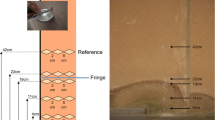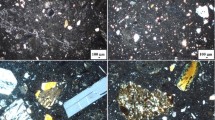Abstract
The crystallisation of soluble salts within the pores of the stone is widely recognised as a major mechanism causing the deterioration of the stone-built architectural heritage. Temperature, in turn, is one of the main controls on this process, including salt precipitation, the pressure of crystallisation and the thermal expansion of salts. Most laboratory experiments on decay generated by salts are just carried out with convective heating regimes, while in natural environments building stones can undergo radiative and convective heating regimes. The thermal response of stone to these different heating regimes is noticeably different and might influence the crystallisation patterns of a salt within a stone. The aim of this work is to raise awareness on the different patterns of crystallisation of NaCl within a porous stone tested with different heating regimes (convection and radiation) and the implications that this could have on the design of experimental modelling of natural weathering conditions in laboratory simulations. Results show that heating regime affects the sodium chloride distribution within a stone with high percentage of microporosity. In this case, radiation heating facilitates the generation of subefflorescences, while convection heating promotes efflorescences. This has a clear implication both on the stone decay in natural environments and on the methodologies for testing salt decay, as subefflorescences are more destructive than efflorescences. In this sense, the use of convective heating in laboratory experimentation might underestimate the potential damage that sodium chloride may generate. This counsels the use of radiation heating test methods in addition to convection for the laboratory study of salt crystallisation.






Similar content being viewed by others
References
ASTM (1964) C218 Method of test for combined effect of temperature cycles and weak salt solution on natural building stone. ASTM, West Conshohocken, Pennsylvania
ASTM (2000) E313–00 Standard practice for calculating yellowness and whiteness indices from instrumentally measure color coordinates. ASTM, West Conshohocken, Pennsylvania
Benavente D (2003) Modelización y estimación de la durabilidad de materiales pétreos porosos frente a la cristalización de sales. Biblioteca Virtual Miguel de Cervantes, http://www.cervantesvirtual.com/FichaObra.html?Ref = 12011 Last access: 15/06/2006
Benavente D, García del Cura MA, Bernabéu A, Ordoñez S (2001) Quantification of salt weathering in porous stones using an experimental continuous partial immersion method. Eng Geol 59:313–325
CEN, (1999) EN 12370. Natural stone test methods—determination of resistance to salt crystallisation. Bruxelles
Cooke RU (1994) Salt weathering and the urban water table in deserts. In: Robinson DA, Williams RBG (eds) Rock weathering and landform evolution. Wiley, Chichester, pp193–205
Cooke RU, Smalley IJ (1968) Salt weathering in deserts. Nature 220:1226–1227
Correns CW (1949) Growth and dissolution of crystals under linear pressure. Disc Faraday Soc 5:267–271
Fort R, Bernabeu A, García del Cura MA, López de Azcona MC, Ordoñez S, Mingarro F (2002) Novelda stone: widely used within the Spanish architectural heritage. Materiales de Construcción 52(266):19–32
Gomez-Heras M (2006) Procesos y formas de deterioro térmico en piedra natural del patrimonio arquitectónico. Madrid: UCM, Servicio de Publicaciones. http://www.ucm.es/BUCM/tesis/geo/ucm-t28551.pdf Last access 15/06/06
Gomez-Heras M and Fort R (2002) Cámara automática para envejecimiento de materiales de construcción por insolación. In. Spanish patent, app n° 200201376: CSIC, p 19
Gomez-Heras M, Benavente D, Alvarez de Buergo M, Fort R (2004) Soluble salt minerals from pigeon droppings as potential contributors to the decay of stone based cultural heritage. Eur J Mineral 16:505–509
Gomez-Heras M, Smith BJ, Fort R (2006) Surface temperature differences between minerals in crystalline rocks: implications for granular disaggregation of granites through thermal fatigue. Geomorphology 78(3–4):236–249
Gomez-Heras M, Smith BJ, and Fort R (2006) Influence of surface heterogeneities of building granite on its thermal microenvironment and its potential for the generation of thermoclasty. Build Environ (in press)
Goudie AS (1974) Further experimental investigation of rock weathering by salt and other mechanical processes. Zeitschr. Geomorphologie N. F. Suppl. Bd. 21:1–12
Goudie AS (1993) Salt weathering simulation using a single-immersion technique. Earth Surf Process Landf 18:369–376
Goudie AS, Viles HA (1995) The nature and pattern of debris liberation by salt weathering: a laboratory study. Earth Surf Process Landf 20:437–449
Goudie AS, Viles HA (1997) Salt weathering hazards. Wiley, Chichester
Griggs DT (1936) The factor of fatigue in rock exfoliation. J Geol 44:783–796
Grossi C.M, Esbert RM (1994) Las sales solubles en el deterioro de rocas monumentales; revisión bibliográfica. Materiales de Construcción. 44:15–30
Hall K, Andre M-F (2003) Rock thermal data at the grain scale: applicability to granular disintegration in cold environments. Earth Surf Process Landf 28:823–836
Halsey DP, Mitchell DJ, Dews SJ (1998) Influence of climatically induced cycles in physical weathering. Quart J Eng Geol 31:359–367
Houck J, Scherer GW (2006) Controlling stress from salt crystallization. In: Kourkoulis SK (ed) Fracture and failure of natural building stones. Proceedings of the international symposium on fracture and failure of natural building stones within the frame of the 16th European conference on fracture, Alexandroupolis, Hellas, July 2006. Springer, Dordrecht, The Netherlands
López de Azcona MC, Mingarro F, Fort R (1996) Estudio Medioambiental en el Palacio Real de Madrid. Geogaceta 20:1155–1158
McGreevy JP, Smith BJ (1982) Salt weathering in hot deserts: observations on the design of simulation experiments. Geografiska Annaler 65A:161–170
Peel RF (1974) Insolation weathering: some measurements of diurnal temperature changes in exposed rocks in the Tibesti region, central Sahara. Zeitschrift für Geomorphologie N. F. Suppl. Bd. 21:19–28
RILEM (1980) Recommended tests to measure the deterioration of stone and to assess the effectiveness of treatment methods (V-1a, V-1b, V-2). Mater Struct 75:175–253
Rodriguez-Navarro C, Doehne E (1999) Salt weathering: influence of evaporation rate, supersaturation and crystallization pattern. Earth Surf Process Landf 24:191–269
Schaffer RJ (1932) The weathering of natural building stones. Building research establishment, Watford
Scherer GW (1999) Crystallisation in pores. Cement Concrete Res 29:1347–1358
Skinner BJ (1966) Thermal expansion. In: Clark SP (ed) Handbook of physical constants.. Geological Society of America Memoir 97
Smith BJ (1977) Rock temperature measurements from the northwest Sahara and their implications for rock weathering. CATENA 4(1–2):41–63
Smith BJ (1978) Aspect related variations in slope angle near Béni Abés.Western Algeria, Geografiska Annaler 60A:175–180
Smith BJ, McGreevy JP (1988) Contour scaling of a sandstone by salt weathering under simulated hot desert conditions.Earth Surf Process Landf 13:697–706
Smith BJ, McGreevy JP, Whalley WB (1987) The production of silt-size quartz by experimental salt weathering of a sandstone. J Arid Environ 12:199–214
Smith BJ, Warke PA, McGreevy JP, Kane HL (2005) Salt-weathering simulations under hot desert conditions: agents of enlightenment or perpetuators of preconceptions? Geomorphology 67(1–2):211–227
Sperling CHB, Cooke RU (1985) Laboratory simulation of rock weathering by salt crystallization and hydration processes in hot, arid environments. Earth Surf Process Landf 10(6):541–555
Steiger M (2005) Crystal growth in porous materials–I: the crystallization pressure of large crystals. J Cryst Growth 282:455–469
Sunagawa I (1981) Characteristics of crystal growth in nature as seen from the morphology of mineral crystals. Bull de Minéralogie 104:81–87
Warke PA, Smith BJ (1998) Effects of direct and indirect heating on the validity of rock weathering simulation studies and durability tests. Geomorphology 22(3–4):347–357
Warke PA, Smith BJ, Magee RW (1996) Thermal response characteristics of stone: implications for weathering of soiled surfaces in urban environments. Earth Surf Process Landf 21:295–306
Winkler EM (1973) Stone: properties, durability in man’s environment. Springer, Berlin Heidelberg New York, 230 pp
Acknowledgments
This work was fully carried out at the Instituto de Geología Económica (CSIC-UCM). Support of the project MATERNAS_CM 0505/MAT/0094 (Madrid’s Regional Government, Spain) is gratefully acknowledged. We wish to thank Bateig Piedra Natural S.A. for supplying samples, Dr. M. Alvarez de Buergo for technical assistance and Dr. D. Benavente and Prof. B.J. Smith for their comments on the manuscript. We would also like to express our gratitude to Dr. Doerhoefer and another, anonymous, reviewer whose comments have been of great help for the improvement of this paper.
Author information
Authors and Affiliations
Corresponding author
Rights and permissions
About this article
Cite this article
Gomez-Heras, M., Fort, R. Patterns of halite (NaCl) crystallisation in building stone conditioned by laboratory heating regimes. Environ Geol 52, 259–267 (2007). https://doi.org/10.1007/s00254-006-0538-0
Received:
Accepted:
Published:
Issue Date:
DOI: https://doi.org/10.1007/s00254-006-0538-0




